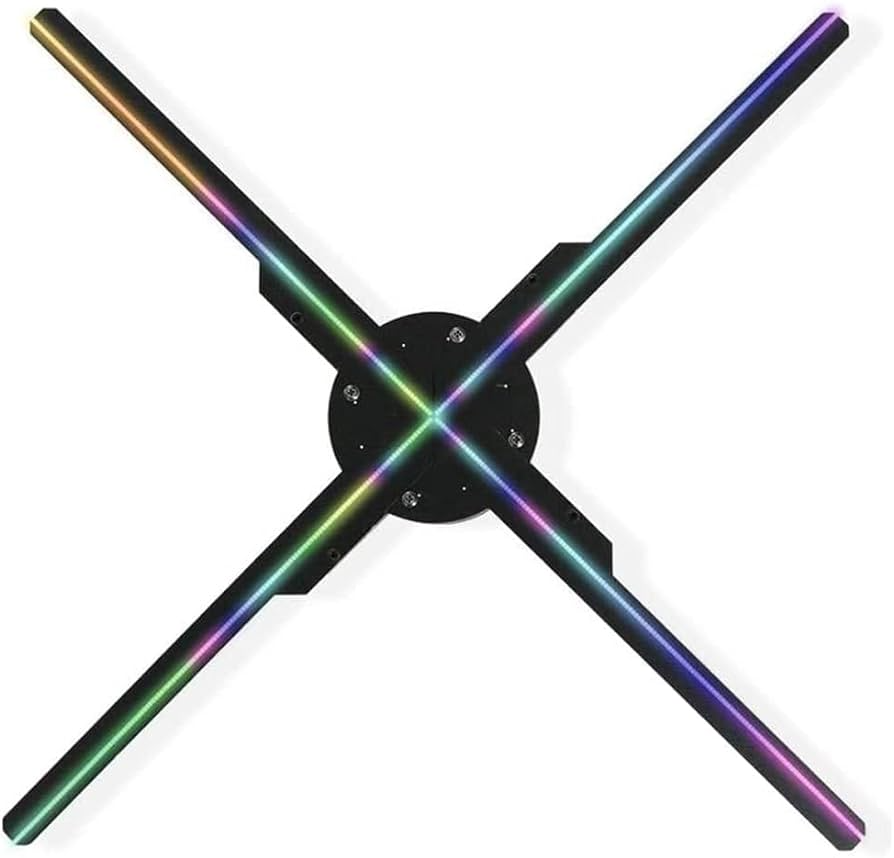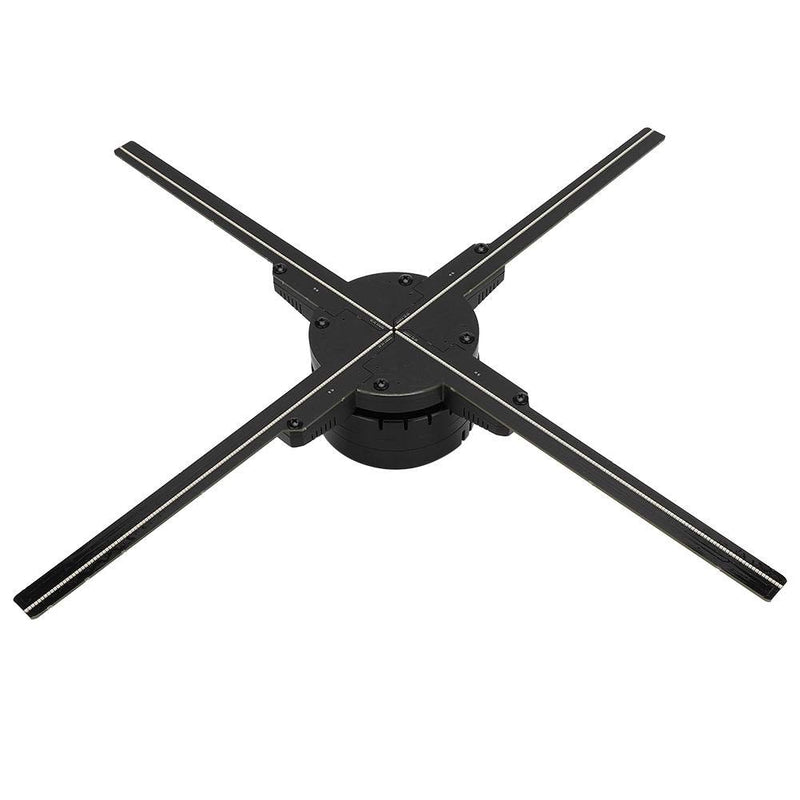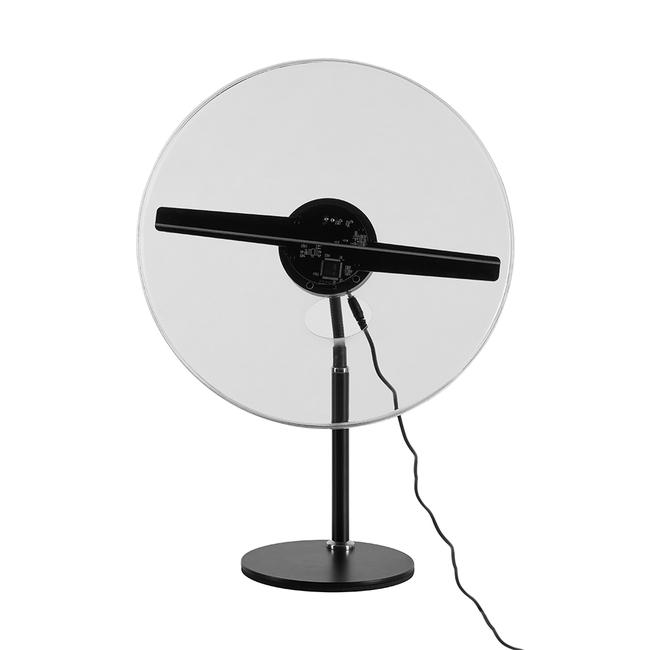Introduction to Hologram Fans
Hologram fans represent a fascinating intersection of modern technology and creative display applications. A hologram fan is an innovative device designed to project holographic images that seem to float in the air. Unlike traditional screens that confine visuals within a rectangular boundary, hologram fans offer a 3D experience that captivates viewers from nearly every angle. These devices are typically composed of spinning LED blades, which, when rotated at high speeds, form images through rapid light emission. They are a testament to how far visual and display technologies have advanced in recent times.
This evolving tech marvel caters to numerous applications. From advertising to entertainment and education, hologram fans offer unique ways to capture attention. Retailers utilize these devices in shop windows to animate their products, creating eye-catching displays that engage passersby. Entertainment sectors deploy them in concerts and shows for immersive experiences. The simplicity behind the technology makes hologram fans accessible to a broad audience, not limited to tech enthusiasts alone. The device’s appeal lies in its blend of cutting-edge technology and its ability to evoke wonder and excitement.
The development of hologram fans is rooted in the principles of persistence of vision. This is where rapid sequences of images blend in our visual perception to create a continuous visual effect. As the blades rotate, the LEDs illuminate in quick succession, tricking our eyes into seeing a hologram. The sophistication of the underlying computation and synchronization is incredible. Algorithms ensure that each tiny LED on the fan blades lights up at precisely the right time, all while giving the illusion of a single, solid image that is coherent and smooth.
Advantages of Hologram Fans
Hologram fans offer myriad advantages, making them valuable in both commercial and personal settings. Firstly, their 3D display capability stands out as the primary benefit. Traditional screens are limited to 2D, but hologram fans lift the images off the screen, making them part of the environment. This elevates user engagement and effectively captures attention, which is particularly useful for advertising.
Efficiency and ease of use further enhance the appeal of hologram fans. Most modern models are designed to be user-friendly, with straightforward setup processes. Often, they come with supportive software to upload and manage content efficiently. Moreover, they are energy efficient. Despite the high-tech output, these devices consume relatively low amounts of electricity, thanks to advancements in LED technology, saving both cost and energy.
Another notable advantage is versatility. Hologram fans can be adapted for different purposes, such as product demonstrations in retail, informational displays at tradeshows, or even educational tools. Their ability to captivate can turn mundane presentations into engaging experiences. For instance, museums can use hologram fans to animate historical artifacts, bringing history to life in a way traditional exhibits cannot. This application transforms the visitor experience, making learning more interactive and enjoyable.
Maintenance and durability are practical concerns addressed by hologram fans. Given their simple mechanical structure, they generally require minimal maintenance. LED lights are known for their longevity, ensuring the device’s extensive operational lifespan. Most components are replaceable and servicable, guaranteeing that a well-looked-after hologram fan will serve its purpose for years. This reliability translates to a sound investment for businesses looking to leverage hologram fans for long-term use.
Evolution and Development
The origins of holographic technology date back several decades, but hologram fans represent a novel adaptation of these foundational concepts. Traditional holography relied on lasers and photographic plates to create 3D images. The process was complex and costly, limiting its application. Advances in digital technology and LED lighting have now made it possible to create cost-effective, practical holographic displays for everyday use.
One of the critical milestones in the development of hologram fans is the integration of software and hardware. The synchronization achieved between the spinning blades and the LED lights is a marvel of engineering. High-speed processors manage the sequence of lights with pinpoint accuracy, creating smooth, continuous images. Furthermore, software developments have enabled more efficient and creative ways to design and upload holographic content. Designers can use specialized software to create intricate patterns and animations custom-tailored to their needs.
Collaboration between different fields of engineering has been instrumental in advancing hologram fan technology. Mechanical engineers, software developers, and graphic designers have collectively contributed to making these devices more user-friendly and accessible. As a result, the technology has evolved rapidly in just a few years, offering more features and better performance at lower costs. The continuous advancement promises even more exciting features, such as interactive elements, where users can control the holograms through gestures or voice commands.
Hologram Fans in Advertising and Marketing
In advertising and marketing, attracting and retaining consumer attention is vital. Hologram fans are a breakthrough in this aspect. They offer a novel way of presenting products and information that immediately grabs attention. Traditional advertisements can blend into the background, but a 3D hologram floating mid-air stands out unmistakably.
Retail stores have started implementing hologram fans to attract customers by displaying floating images of products, special deals, or creative graphics. By placing these devices in strategic locations, like storefronts or exhibition booths, retailers can engage potential customers before they even walk through the door. For example, imagine walking past a shoe store and seeing a life-size shoe model rotating in the air, showcasing its features from all angles. That’s the kind of attention-grabbing display that makes hologram fans so valuable.
Moreover, hologram fans can enhance brand visibility in environments saturated with advertisements. They can be programmed to display intricate animations and dynamic content that evolves. This versatility keeps the display fresh and engaging, unlike static billboards or posters. Businesses can also easily update their holographic content to reflect seasonal promotions or new product lines, ensuring their advertising strategies remain current and relevant.
Besides physical stores, event marketers are finding innovative uses for hologram fans at corporate events, trade fairs, and exhibitions. These venues are often marked by an information overload, with each brand competing for some spotlight. A hologram fan creating a captivating 3D display can effectively cut through the clutter and draw visitors to the stall. They can be used to showcase product demos, provide immersive infographics, or simply draw in crowds with impressive visuals.
Impact on Entertainment
The entertainment industry has always been a fertile ground for adopting new technologies, and hologram fans are making a mark here as well. These devices offer myriad possibilities for creating stunning visual effects. Concerts and live performances, for example, can be transformed by incorporating hologram fans. Artists can share the stage with 3D representations, creating a show that is both visually and emotionally engaging. This is not just limited to the stage; the entire venue can be turned into an interactive space with multiple hologram fans set up around the area.

In the film industry, hologram fans can offer novel ways to create interactive movie experiences. Imagine watching a film where key scenes come to life in front of you through 3D holograms. This could redefine the movie-going experience, creating a more immersive environment. The use of hologram fans in theme parks and amusement parks is another area showing promise. They can be used in rides and attractions to make experiences more lifelike and engaging.
Beyond live performances and interactive experiences, hologram fans have a place in home entertainment. They can be linked with gaming systems to bring an extra dimension to video games. Instead of playing in front of a flat screen, players can see elements of the game extending into their living space. This kind of immersive gameplay promises to revolutionize the way we experience digital entertainment.
Education and Training
The educational sector is increasingly recognizing the potential of hologram fans. These devices can significantly enhance the learning experience by making abstract concepts tangible. For instance, in medical education, students can benefit from 3D representations of human anatomy, making it easier to understand complex biological structures. These holographic images can be rotated, zoomed in, and explored in a way that traditional textbooks or even 2D computer screens cannot match.
In disciplines like engineering and architecture, students can utilize hologram fans to visualize projects in 3D, providing a better understanding of spatial relationships and mechanics. This real-time 3D visualization fosters a more interactive and engaging learning environment. Virtual simulations created through hologram fans could replace traditional models, offering a more versatile and dynamic tool for educational purposes.

Corporate training programs can also benefit immensely. Training modules often require the illustration of complex machinery, processes, or scenarios. Hologram fans can create realistic simulations that help trainees understand and retain information more effectively. This interactive form of learning can make training sessions more engaging and, consequently, more fruitful.
Another significant advantage is accessibility. As hologram fans become more affordable and straightforward to use, educational institutions of all sizes can adopt this technology. Rural schools, which might lack the resources for advanced educational tools, can leverage hologram fans to offer their students world-class learning aids. This can help bridge educational divides, offering equal learning opportunities regardless of geographical location.
The Future of Hologram Fans
The future of hologram fans looks incredibly promising.
As technology continues to advance, we can expect even more sophisticated and versatile applications. One exciting area of development is interactive holograms. With advancements in gesture recognition and AI, future hologram fans could offer interactive capabilities. Users could manipulate the holographic images using hand gestures or voice commands, opening up endless possibilities for engagement and interaction.
Furthermore, the combination of hologram fans with augmented reality (AR) could create even richer experiences. Imagine shopping in a store where you can not only see but also interact with 3D representations of products. This convergence of hologram and AR could revolutionize retail, marketing, entertainment, and more.
The integration of higher resolution and color fidelity, making holographic images even more lifelike.
Another future development is the integration of higher resolution and color fidelity, making holographic images even more lifelike. Today’s hologram fans are already impressive, but future models could offer near-perfect replication of real-world objects. This can enhance applications across various sectors, making the technology even more versatile and indispensable.
With the growing adoption and recognition of hologram fans, we can expect more creative uses of this technology. From creating unforgettable advertising experiences to enriching educational content and enhancing home entertainment, the potential is limitless. As hologram fans become more advanced and accessible, they will undoubtedly play a more significant role in our daily lives, opening new doors for innovation and creativity.
Conclusion
In conclusion, hologram fans are more than just a technological novelty. They represent a revolutionary step in how we can present and interact with visual content. With the advantages of 3D display capabilities, versatility, and engaging user experiences, hologram fans are poised to become a mainstay in various industries. As we look to the future, the potential applications and advancements in this field promise to continuously transform and enhance the way we see the world around us.



